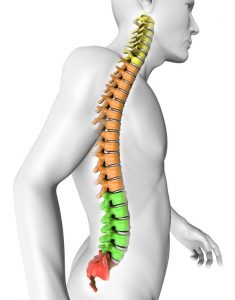
Normal S shape spine

The reason that driving or sitting for that matter causes your back to ache is fairly simple. The entire back in standing is very cleverly designed to form an “S” curve when viewed sideways in order to cope with the everyday stresses placed on it. This creates a spring or bounce effect with stresses to the back. The lower back in particular has the inward curve of the “S” so that when viewed from the side the curve curves towards the tummy. When sitting, your legs are high in front of you, and this pulls the pelvic bones around so that this inward curve becomes either straight or curves the other way. So often your back takes on the “C” shape instead of the “S”. This places a significant amount of stress on the back which can be enhanced and aggravated by vibration e.g. when travelling. At first you may only experience stiffness getting out of your seat, then this will progress to stiffness and eventual pain while sitting and sit to stand. The back can only take so much stress until small degenerative changes start to occur ever so slowly to try to accommodate this stress. We are not designed to sit for long periods in this poor postural positioning. In most cases the stress builds up slowly until it becomes too much and pain begins.
Despite technology most seats do not have enough lower back support. There are a variety of supports that can assist to reduce the load of spines in sitting. These are worth trialing. The reality is our bodies are not designed to sit for a long period of time. Stretching and standing activities should be done regularly if sitting for long periods.
Travelling by car? Newer cars are much better than the older cars where there is often little choice between a bucket seat and a straight-backed seat. The newer cars do have adjustable lower back support which while being an improvement on the older cars still need some technology years to refine the perfect sitting position. Let’s face it they are still trying to find the perfect chair for office work and more technology is needed for this. While we are not suggesting you buy a new car, the seat may need replacing if it is considerably vintage. However there are various supports that you can buy which fit into a car seat and will support your back. Basically you need to produce an inward curve of you lower back and if you do that you will be able to drive long distances much more comfortably. A quick solution is to invest in a lumbar roll which retails cheaply from most physiotherapy clinics and adds some support. A cushion/pillow may also assist as long as your lower back is in an inward curve position. There are also more fancy expensive options which support both the back and the pelvic area. Mind you in saying all this there are some seats that despite back cushions and modifications etc. need to be put on the trash heap. No matter what you do to them, they stress your back. When travelling if possible, make sure your knees are below your hips as this will help reduce the load on your back by maintaining the normal curves.
If your pain does not settle or seems to be getting worse, get some advice/treatment from your local physiotherapist. Often treatment combined with a home program will resolve the pain. Surgery and invasive treatments can usually be avoided with early physiotherapy.

